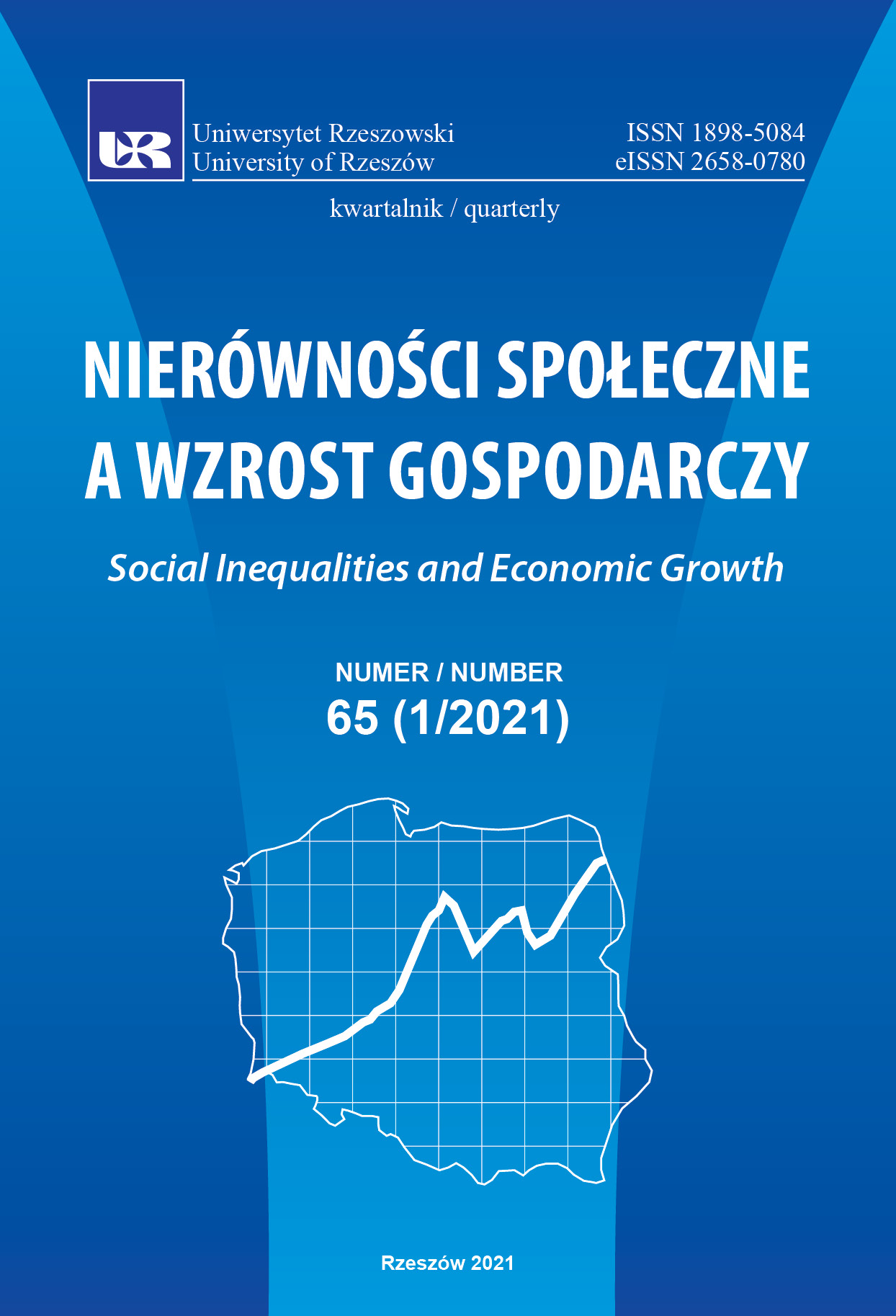Cyfryzacja polskich przedsiębiorstw na tle wybranych krajów europejskich
DOI:
https://doi.org/10.15584/nsawg.2021.1.5Słowa kluczowe:
technologie informacyjno-komunikacyjne, metoda Z. Hellwiga, e-handel, chmura obliczeniowa, integracja procesów wewnętrznych, nierówności w zakresie wykorzystania technologii informacyjnychAbstrakt
W artykule podjęto próbę oceny poziomu wykorzystania technologii informacyjnych w polskich przedsiębiorstwach na tle wybranych państw europejskich. Badania własne wykazały nierówności w zakresie wykorzystania technologii informacyjnych przez przedsiębiorstwa krajów europejskich. W świetle wyników badań własnych poziom wykorzystania technologii informacyj
no- komunikacyjnych przez polskie przedsiębiorstwa jest niski. Polska uplasowała się na 24. pozycji w rankingu krajów objętych badaniem. Słabością polskich przedsiębiorstw jest relatywnie niski poziom wykorzystywania usług przetwarzania w chmurze oraz mediów społecznościowych. Polska wypada najlepiej pod względem dostępu do Internetu i wykorzystania IT w zakresie integrowania procesów wewnętrznych oraz kontaktów z klientami, dostawcami, zarządzania łańcuchem. W świetle przyjętych cech diagnostycznych najwyższy poziom wykorzystania technologii informacyjno-komunikacyjnych w przedsiębiorstwach jest charakterystyczny dla: Danii, Finlandii, Holandii, Irlandii. Krajami o najniższym poziomie wykorzystania technologii informacyjno-komunikacyjnych przez przedsiębiorstwa są: Grecja, Łotwa, Węgry, Bułgaria i Rumunia.
Downloads
Bibliografia
Bartuś, T., Bartuś, K. (2012). Zastosowanie analitycznych systemów zarządzania relacjami z klientami w przetwarzaniu wiedzy o klientach rynku elektronicznego. Studia Ekonomiczne, 100, 45–56.
Billon, M., Marco, R., Lera-Lopez, F. (2009). Disparities in ICT adoption: a multidimensional approach to study the cross-country digital divide. Telecommunications Policy, 33(10–11), 596–610.
Carlsson, B. (2004). The digital economy: what is new and what is not? Structural Change and Economic Dynamics, 15(3), 245–264.
Cruz-Jesus, F., Oliveira, T., Bacao, F., Irani, Z. (2017). Assessing the pattern between economic and Digital development of countries. A Journal of Research and Innovation, 19(4), 835–854. DOI:10.1007/s10796-016-9634-1.
Cruz-Jesus, F., Oliveira, T., Bacao, F. (2012). Digital divide across the European. Union. Information & Management, 49(6), 278–291. DOI:10.1016/j.im.2012.09.003.
Cyfrowa przyszłość Europy. (2020). Pobrane z: https://www.consilium.europa.eu/pl/policies/a-digital-future-for-europe/ (2020.11.01).
Dewan, S., Riggins, F. J. (2005). The digital divide: current and future research directions. Journal of the Association for Information Systems, 6(12), 298–337.
Dudziak, A., Stoma, M., Rydzak, L. (2017). Narzędzia klasy ERP w strategii zarządzania produkcją. Zeszyty Naukowe. Organizacja i Zarządzanie 113, 53–65. DOI: 10.29119/1641-3466.2017.113.4
European Commission (2020). Digital Economy and Society Index (DESI) 2020. Integration of digital technology. Pobrane z: https://ec.europa.eu/digital-single-market/en/digital-economy-and-society-index-desi (2021.03.09.03).
Eurostat. Pobrane z: https://ec.europa.eu/eurostat/data/database (2020.09.01).
Frąckiewicz, E. (2006). Marketing internetowy. Warszawa: Wydawnictwo Naukowe PWN.
Gołąb-Andrzejak, E. (2016). Konsumenci pokolenia Y – nowe wyzwanie dla komunikacji marketingowej. Handel Wewnętrzny, 2(361), 140–151.
Jadczak, A. (2018). Cyfrowe przedsiębiorstwa: na jakim etapie jest Polska? Pobrane z: https://itwiz.pl/cyfrowe-przedsiebiorstwa-na-jakim-etapie-jest-polska/ (2020.09.08).
Jalava, J., Pohjola, M. (2008). The roles of electricity and ICT in economic growth: Case Finland. Explorations in Economic History, 45(3), 270–287.
Julius, L. V., Emchuk, L. V. (2015). Information systems and their role in the modern enterprises activities. W: Perspective economic and management issues. Collection of scientific articles. Scientific Journal, Economics and Finance & East West Association for Advanced Studies and Higher Education,130–134.
Kuźniar, M. (2012). O chmurach i niechmurach. Czyli czym się różni cloud computing od zwykłego hostingu. Pobrane z: https://spidersweb.pl/2012/12/maciej-kuzniar-chmurach-niechmurach-czyli-czym-sie-rozni-cloud-computing-od-zwyklego-hostingu.html (2020.09.05).
Mróz, B. (2010). Nowe trendy konsumenckie – szansa czy wyzwanie dla marketingu. W: Sz. Figiel (red.), Marketing w realiach współczesnego rynku. Implikacje otoczenia rynkowego (s. 385– 399). Warszawa: PWE.
Raport: Przemysł 4.0 w Polsce – rewolucja czy ewolucja? (2020). Pobrane z: https://www2.deloitte.com/pl/pl/pages/technology/articles/raport-przemysl-4-0-rewolucja--czy-ewolucja.html (2020.10.10).
Social Media Trends 2020. Report. (2020). Pobrane z: https://hootsuite.com/resources/social-media-trends-2020-report (2020.11.10).
Sokołowski, A., Wrzalik, A., Niedbał, R. (2017). Systemy monitoringu sieci Internet skutecznym elementem kreowania strategii marketingowej. Marketing i Rynek, 7,684–694.
Strahl, D. (2006). Metody oceny rozwoju regionalnego. Wrocław: Wydawnictwo AE im. O. Langego.
Sysło, M. (2005). Rozwój technologii informacyjnej a edukacja – stan, kierunki, wyzwania. W: B. Niemierko, G. Szyling (red.), Holistyczne i analityczne metody diagnostyki edukacyjnej. Perspektywy informatyczne egzaminów szkolnych (s. 48–67). Gdańsk: Fundacja Rozwoju Uniwersytetu Gdańskiego.
Szul, E. (2013). Prosumpcja jako aktywność współczesnych konsumentów – uwarunkowania i przejawy. Nierówności Społeczne a Wzrost Gospodarczy, 31, 347–358.
Witczak-Roszkowska, D. (2020). The virtual dimension of socio-economic relations in European countries. Scientific Papers of Silesian University of Technology. Organization and Management, 146, 509–522. DOI: 10.29119/1641-3466.2020.146.36.
W stronę przemysłu 4.0. (2019). Innovation. Data. Knowledge. Pobrane z: https://przemysl-40.pl/wp-content/uploads/2019-Badanie-Rynku-Przemysl40.pdf (2020.10.05).
Pobrania
Opublikowane
Jak cytować
Numer
Dział
Licencja

Utwór dostępny jest na licencji Creative Commons Uznanie autorstwa – Na tych samych warunkach 4.0 Miedzynarodowe.


